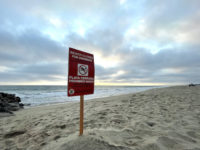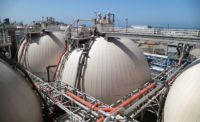After a clog at the Hyperion Water Reclamation Plant that serves the Metro Los Angeles area flooded the facility and forced it to release 17 million gallons of untreated wastewater into Santa Monica Bay earlier this month, potentially toxic odors from the under-repair plant are making nearby residents sick. The Los Angeles Department of Health is advising affected residents to stay indoors as much as possible.
The health department’s readings of the air around the Playa del Rey, Calif. plant and in adjacent City of El Segundo, Calif., found levels of hydrogen sulfide to be non-detectable and does not expect gases from the incident to reach levels that pose an imminent health threat, a spokesperson from Los Angeles County Department of Public Health tell ENR.
“However, even at very low levels, odors from these gases may cause real health impacts, such as eye irritation, nausea, vomiting, headaches, and other symptoms,” the health department says. “Nearby residents affected by odors should keep their doors and windows shut as much as possible. People with persistent or worsening symptoms should visit their healthcare providers.”
Hyperion’s facility manager says repairs to return full-functionality could take months – and the health department says it expects the odors continue to impact the air “for weeks.” Hyperion, one of the largest in the U.S., emits strong, foul odors as workers continue to repair and sanitize it and burn off excess digestor gas that the facility is unable to process. The plant, which treats about 300 million gallons per day, is designed to handle up to 800 mgd at peak.
“The materials handled at this facility may contain some toxic air contaminants, which is controlled by the permitted equipment and subject to South Coast AQMD regulations,” says Bradley Whitaker, spokesperson for South Coast Air Quality Management District, an air pollution control agency for major portions of Los Angeles, Orange, San Bernardino and Riverside counties, and that the foul odors can cause temporary symptoms such as headaches and nausea, which typically go away when the odor is no longer present.
Whitaker says the primary source of the odor is the sewage from the July 11 incident, when crews noticed large debris clogging the headworks screens where wastewater enters the plant. The wastewater backed up, submerging a significant portion of the plant and causing major damage to equipment that cleans Los Angeles County wastewater, says Timeyin Dafeta, Hyperion's executive plant manager.
“The damage is largely due to flooding in plant facilities that impacted electrical motors, wiring, and instrumentation that enable pumps to convey flow through the wastewater treatment process,” a Hyperion official tells ENR.
Wastewater enters the plant at an average speed of two to five feet per second and first goes through preliminary treatment, starting at the headworks, where the largest solids, such as plastics and branches, and smaller solids, like sand, are filtered through eight screens, which are metal racks of steel bars ¾-in. apart. Three or four screens are typically opened at once and are sufficient to handle daily flow that comes into the plant by five major lines. A large mechanical rake then removes the solids from screens and deposits the items into a trough. This waste is dewatered and stored in large silos, then taken to a landfill.
Typically, wastewater, propelled by gravity, moves through the treatment process and flows, cleaned, through five miles of pipe offshore of Dockweiler State Park in Playa Del Rey into the Pacific Ocean. Another one-mile pipe offshore deposits stormwater, but also acts as an emergency outlet for the plant.
With the debris, however, water could not pass the screens and flooded the plant into the street and into the attached storm drain system. Normally, any water that spills over into the storm drain is pumped back to the headworks for preliminary screening and treatment.
A bypass gate is built into the headworks for emergencies to release the pressure from the incoming water. But the pressure was too great and the risk to workers too high to open the gate, Dafeta says.
Hyperion staff made the decision to release untreated water through the one-mile pipe to mitigate a more catastrophic outcome, which could have included the entire plant going offline, says Dafeta, adding that an investigation into the incident will take “considerable” time.
“Overflow of wastewater from the plant headworks flowed through roadways within the plant, inundated multiple buildings on site, flooded underground pipe galleries, submerged equipment and caused significant damage,” according to a Hyperion July 21 statement. At about 4:30 a.m. on July 12, crews opened the bypass gate to release pressure and stop the flooding in the plant and overflow of wastewater into the one-mile outfall. But Hyperion had already discharged the 17 million gallons of sewage (6% of a daily load) over eight hours through the one-mile outfall, according to the plant statement.
Despite initial reports, Dafeta says power was not a factor in the incident.
Repairs and Reaction
Meanwhile, elected officials and local residents have questions – and complaints. Residents of adjacent El Segundo, Calif., have reported a strong odor of sewage throughout the town and is causing headaches, nausea and rashes. El Segundo resident Ryan Osborne says he was approached on the sidewalk July 19 by a health department worker and asked if he noticed the odor and if he or his family felt ill. The health department did not respond to repeated requests for more information at publication time.
Hyperion says repairs could take months, and flooding significantly reduced the amount of digester gas available to generate power, resulting in a temporary shutdown of the Hyperion Bioenergy Facility. Unused gas is being burned off. Hyperion says the odor and burnoff meet levels set by the South Coast AQMD.
“The facility is required to burn the digester gas in the appropriate permitted equipment. As part of South Coast AQMD’s permitting process, we evaluate the compounds that are expected to be emitted from the equipment and conduct a health risk assessment to ensure compliance with South Coast AQMD’s health risk requirements,” says Whitaker, who notes that digester gas consists mainly of methane and carbon dioxide, but a small portion comes from compounds like volatile organic compounds, ammonia and sulfur compounds such as hydrogen sulfide. “Permit conditions for the air pollution control equipment are enforced to ensure the operation remains below health risk levels.”
South Coast AQMD did receive odor complaints from the surrounding community but was unable to verify enough complaints on any one day to establish a public nuisance.
“Although odors can cause temporary health symptoms such as headaches and nausea, it is recognized that repeated exposures to foul odors can have impacts on the quality of life,” says South Coast AQMD.
In response, the city of Los Angeles says it will reimburse El Segundo residents for air conditioners and hotel rooms.
Leaders and residents also want an explanation for the delay in public notification and beach closures. Beaches stayed open to swimmers, including large groups of children at beach camps, with the health department issuing an official statement nearly 18 hours after the incident started.
The Los Angeles Sanitation & Environment Agency (LASAN) notes that current protocol requires Hyperion to notify state agencies, which then notify the public and take other appropriate measures, such as closing beaches or issuing public alerts. The state health department says it followed its own protocol by notifying elected officials, who it says should notify the public at large.
“My office was not notified that this incident occurred,” said LA City Controller Ron Galperin, in a July 21 letter to Barbara Romero, director and general manager of LASAN. “What notices did LASAN provide the public besides posting on social media? At what time were public notices provided, compared to when LASAN staff were first made aware of the problem?”
The health department says it is working with the chief executive office and other county departments, “to examine the spill event and to develop a corrective action plan that will result in faster response, coordination, reporting and communication.”
Galperin also wants to know he criteria that would prompt an emergency alerts via a mass notification system and seeks answers from LASAN by July 30.




